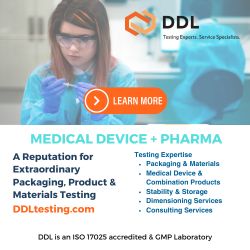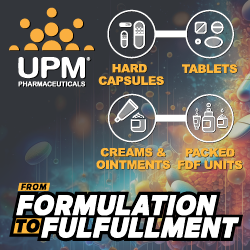Bio Platforms
Biogen & Denali Sign Co-Development/Co-Commercialization Agreement
Biogen Inc. and Denali Therapeutics Inc. recently announced they have signed a binding agreement to co-develop and co-commercialize Denali’s small molecule inhibitors of leucine-rich repeat kinase 2 (LRRK2) for….
Immatics Extends Cell Therapy Manufacturing Collaboration With UTHealth
Immatics N.V. recently announced the extension of its cell therapy manufacturing collaboration with The University of Texas Health Science Center at Houston (UTHealth)….
Immunic, Inc. Reports Positive Top-line Data From Phase 2 EMPhASIS Trial
Immunic, Inc. recently announced positive top-line data from its phase 2 EMPhASIS trial of lead asset, IMU-838, the company’s selective oral DHODH inhibitor, in patients…
FDA Approves Two Emergency INDs for COVID-19 Outpatient Therapy
Organicell Regenerative Medicine, Inc. recently announced the US FDA approved two outpatient Emergency Investigational New Drug Applications (eINDs) for treating mild-to-moderate respiratory distress due to…
Rafael Pharmaceuticals Achieves Target Enrollment of 500 Patients in Pivotal Phase 3 Trial
Rafael Pharmaceuticals, Inc. recently announced it has reached its target enrollment of 500 patients in its pivotal Phase 3 clinical trial for metastatic pancreatic cancer…
Catalent Gene Therapy Facility Receives FDA Approval as an Additional Manufacturing Site for AveXis' Gene Therapy
Catalent recently announced that it was approved by the US FDA to produce commercial drug substance intermediate for AveXis’ spinal muscular atrophy (SMA) gene therapy…
Editas Medicine Enters Into Strategic Partnership With Catalent to Support Gene-Editing Medicine Pipeline
Editas Medicine, Inc. and Catalent recently announced they have entered into a strategic partnership whereby Catalent will provide support for the development, manufacturing, and clinical supply of….
Arrowhead Pharmaceuticals Earns $20-Million Milestone Payment From Amgen
Arrowhead Pharmaceuticals Inc. recently announced it has earned a $20-million milestone payment from Amgen following the administration of the first dose of….
DalCor Announces dal-GenE Trial Continues With Final Data Expected in the First Half of 2021
DalCor Pharmaceuticals recently announced that the independent dal-GenE Data and Safety Monitoring Board (DSMB) recommends the dal-GenE pivotal outcomes trial should continue as planned with…
Don’t Miss RNA Medicine in a Pandemic Symposium on July 23!
Join us as we are hosting an RNA Symposium bringing together leading experts in RNA medicine, delivery, technology development, and solutions for manufacturing to present and discuss…
Apellis Completes Enrollment in Phase 3 Study of Pegcetacoplan
Apellis Pharmaceuticals, Inc. recently announced the completion of enrollment in the global Phase 3 PRINCE study, which is evaluating pegcetacoplan (APL-2) in….
Geron Receives Positive Opinion from the EMA Committee for Orphan Medicinal Products
Geron Corporation recently announced the European Medicines Agency (EMA) Committee for Orphan Medicinal Products (COMP) issued a positive opinion on the company’s application for orphan…
Bioasis & Chiesi Group Announce Rare Diseases Strategic Alliance
Bioasis Technologies, Inc. and Chiesi Global Rare Diseases recently announced they have entered into a worldwide, exclusive licensing agreement for the….
Intra-Cellular Therapies Announces Positive Top-line Results from Phase 1/2 Study
Intra-Cellular Therapies, Inc. recently announced topline results from Study ITI-214-104, a Phase 1/2 translational study of single ascending doses of ITI-214, a novel, selective phosphodiesterase-1…
Oncology Venture Signs Agreement to Out-License Two Pipeline Assets
Oncology Venture A/S (OV) recently announced it has signed a definitive agreement out-licensing two clinical pipeline assets, LiPlaCis and 2X-111, to Smerud Medical Research International…
Moderna & Catalent Announce Collaboration for Fill-Finish Manufacturing of Moderna's COVID-19 Vaccine Candidate
Moderna, Inc. and Catalent, Inc. recently announced a collaboration for large-scale, commercial fill-finish manufacturing of Moderna’s mRNA-based COVID-19 vaccine candidate…..
Yumanity Therapeutics Announces Strategic Research Collaboration & License Agreement With Merck
Yumanity Therapeutics recently announced it has entered into a strategic research collaboration and license agreement with Merck focused on accelerating….
Mateon & GMP Completed Research & Service Agreement
Mateon Therapeutics, Inc. recently announced that both Golden Mountain Partners (GMP) and Mateon have fulfilled all the obligations under the Research and Services Agreement entered on….
AGTC Announces Significant Productivity & Quality Enhancement to Its Proprietary Manufacturing Process
Applied Genetic Technologies Corporation recently provided an update on the continued productivity and quality improvements made in its proprietary manufacturing platform that is….
Provectus Biopharmaceuticals Announces Discovery of Unique PV-10-Induced STING Pathway Mechanism
Provectus recently announce that data from ongoing preclinical study of investigational autolytic cancer immunotherapy PV-10 (rose bengal disodium) was presented at the American Association for…
What are Bio Platforms?
Platforms (or asset-independent technologies to capture all kinds of capabilities that can be leveraged across many different drug candidate assets rather than just discovery tools that the term ‘platform’ immediately brings to mind) are ubiquitous in modern pharma. They are the product of an arms race, to secure access to the best capabilities in key areas.
Platform technologies are considered a valuable tool to improve efficiency and quality in drug product development. The basic idea is that a platform, in combination with a risk-based approach, is the most systematic method to leverage prior knowledge for a given new molecule. Furthermore, such a platform enables a continuous improvement by adding data for every new molecule developed by this approach, increasing the robustness of the platform.
But it has often been said that access to the latest technological platforms to aid efficient drug discovery and development is limited to Big Pharma, which can more easily justify the costs of creating and operating these platforms.
Benefits of Bio Platforms
Platform technologies have the ability to radically improve upon current products and generate completely novel products. In this sense, they open up new arenas for drug discovery and development, potentially increasing the number of therapeutic options for patients. Once a single compound or therapeutic has been generated and demonstrates a clinical benefit in patients, it is more likely this platform technology can successfully be applied to other therapeutic areas, derisking future compounds/products.
Complex drugs by their very nature are challenging and costly to manufacture. This, in turn, translates into higher costs for patients and other payers. In order to provide safe and effective therapies at a reasonable price, it is necessary for the industry to develop manufacturing technologies that reduce costs and provide a consistent product. While the initial investment may be larger, manufacturing costs will be lower over time as the manufacturing process is solidified.
Scale and Investment of Bio Platforms
Despite the initial upfront costs, platform technologies inevitably provide pragmatic solutions to production challenges, while yielding safer and more effective therapeutic products. It has often been said that one of the key features that distinguishes “Big Pharma” from biotech is access to the latest technological platforms to aid efficient drug discovery and development.
These platforms range from vast chemical libraries, ultra-high throughput screening and huge genetic databases in discovery, to predictive toxicology platforms, cutting-edge ‘omics’ and even deep-seated knowledge of particular therapeutic areas in development. All these platforms have two things in common: They can be used on any (or many) development candidate assets, and they cost huge sums to establish in the first place, and in a few cases each time they are used as well. Hence their restriction to the largest pharmaceutical companies (and a few of the so-called “big biotechs” that are, in many ways, indistinguishable from the old-guard pharma).
Only when you have hundreds of active projects can you justify the cost of creating and operating these platforms. Or so the mantra goes. It is access to these platforms that keeps the big companies ahead in the race to discover and develop the best medicines (or at least counterbalance the disadvantages of being large and slow-moving, depending on your point of view). But is that just an assertion? How much evidence is there to support the proposition that the efficiency gains due to these platforms outstrips the cost of creating and maintaining them?
Keeping these technologies “cutting edge” has become so expensive that increasingly we hear pharma companies talking of “pre-competitive” approaches to develop the next generation. A group of companies might develop a platform capability they then share. The principle goal of such initiatives is to access even grander and more expensive tools than individual companies could afford, rather than to dramatically cut costs (although sharing platforms rather than developing the same thing in parallel in each silo should at least keep a lid on rising costs).


















